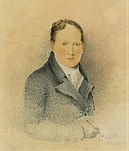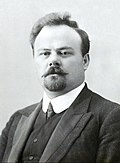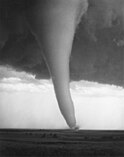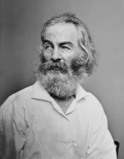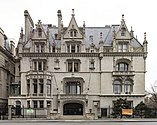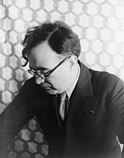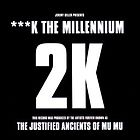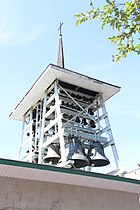| << | Today's featured articles for November 2021 | >> | ||||
|---|---|---|---|---|---|---|
| Su | Mo | Tu | We | Th | Fr | Sa |
| 1 | 2 | 3 | 4 | 5 | 6 | |
| 7 | 8 | 9 | 10 | 11 | 12 | 13 |
| 14 | 15 | 16 | 17 | 18 | 19 | 20 |
| 21 | 22 | 23 | 24 | 25 | 26 | 27 |
| 28 | 29 | 30 | ||||
November 1
Charles Green (26 December 1919 – 1 November 1950) was an Australian Militia officer who volunteered for overseas service at the start of World War II. He fought in Greece in 1941 and returned to Australia in 1942. From March to July 1945, Green commanded the 2/11th Battalion during the Aitape–Wewak campaign in New Guinea, becoming the youngest Australian infantry battalion commander. For his performance during the campaign, Green was made a Companion of the Distinguished Service Order. He later commanded the 3rd Battalion, Royal Australian Regiment (RAR), during the Korean War. The battalion joined UN forces and advanced into North Korea, fighting in the Battles of the Apple Orchard, the Broken Bridge and Chongju. On 30 October 1950, Green was wounded in the stomach by a shell fragment. Evacuated to hospital, he died of his wounds two days later, aged 30, and was subsequently awarded the US Silver Star. He remains the only commanding officer of an RAR battalion to die on active service. (Full article...)
November 2
Energy is sustainable if it meets the needs of the present without compromising the ability of future generations to meet their needs. Sustainability issues in the current energy system include high emissions of greenhouse gases, air pollution from the burning of fossil fuels and biomass, and pervasive energy poverty in developing countries. The scientific literature on limiting global warming describes pathways in which the world rapidly phases out coal-fired power plants, produces more electricity from clean sources such as wind and solar, shifts towards using electricity instead of fuels in sectors such as transport and heating buildings, and takes measures to conserve energy. These changes would involve a system-wide transformation of the way energy is produced, stored, distributed, and consumed. Decarbonization of the energy system would bring major co-benefits to human health and can be done in concert with providing universal access to electricity and to clean cooking. (Full article...)
November 3
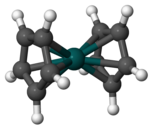
Rhodocene is an organometallic compound with the formula [Rh(C5H5)2]. Each molecule contains an atom of rhodium bound between two planar systems of five carbon atoms known as cyclopentadienyl rings in a sandwich arrangement. The [Rh(C5H5)2] radical is found above 150 °C or when trapped by cooling to liquid nitrogen temperatures (−196 °C). At room temperature, pairs of these radicals join via their cyclopentadienyl rings to form a dimer, a yellow solid. Biomedical researchers have examined the applications of rhodium compounds and their derivatives in medicine and reported one potential application for a rhodocene derivative as a radiopharmaceutical to treat small cancers. Rhodocene derivatives are also used to study metal–metal interactions in linked metallocenes which can potentially be used to make molecular electronics. Rhodocene can be synthesized by reacting rhodium chloride hydrate, cyclopentadiene, and ammonium hexafluorophosphate. (Full article...)
November 4
Rockstar San Diego is an American video game developer known for the Red Dead, Midnight Club, and Smuggler's Run franchises. Founded by Diego Angel in January 1984 as Angel Studios, it was initially a work-for-hire animation studio, working on films such as The Lawnmower Man (1992) and the music video for the song "Kiss That Frog" (1993). The company shifted towards video game development in the 1990s. In its early years in the sector, it was responsible for the Nintendo 64 port of Resident Evil 2 (1999) and cooperated with Nintendo on multiple projects. The studio's work on Midtown Madness (1999) attracted the attention of Rockstar Games, which worked with the studio on the Midnight Club and Smuggler's Run series, both first released in 2000. Take-Two Interactive acquired Angel Studios for Rockstar Games in November 2002, renaming the studio Rockstar San Diego. Under Rockstar Games, the studio developed Red Dead Revolver (2004), further Midnight Club games, and Red Dead Redemption (2010). (Full article...)
November 5
John Thirtle (1777–1839) was an English watercolour artist and frame-maker. Born in Norwich, where he lived for most of his life, he was a leading member of the Norwich School of painters. He produced frames for paintings by several members of that school, including John Crome and John Sell Cotman. He also worked as a drawing-master, a printseller and a looking glass maker. At the Norwich School's first exhibition in 1805, Thirtle exhibited five paintings as one of the five featured artists. Most of his watercolours are of Norwich and the surrounding Norfolk countryside. His style, influenced by Thomas Girtin, Crome and Cotman, was technically accomplished. His earlier landscapes were painted with a restricted range of buffs, blues and grey-browns, but he later developed a brilliancy of colour, producing works that included angular block forms. His Manuscript Treatise on Watercolour, unpublished before 1977, was probably for his own use, and he exhibited fewer than 100 paintings. (Full article...)
November 6
The Idiot is the debut studio album of American musician Iggy Pop, released on March 18, 1977, by RCA Records. In 1976 Pop accompanied his friend David Bowie to Europe to rid themselves of their drug addictions. There Bowie agreed to produce an album for Pop. Recording began in June 1976 and further sessions took place at Musicland Studios in Munich in August. Bowie composed most of the music and contributed a major portion of the instrumentation, while Pop wrote most of the lyrics. The album's title was taken from Fyodor Dostoevsky's novel of the same name, while Erich Heckel's painting Roquairol inspired its artwork. When released the album received divided, albeit largely positive, reviews. It charted in the US, the UK, and Australia. Pop supported The Idiot with a tour in 1977, with Bowie as his keyboardist. The Idiot has continued to be received positively, with many noting Pop's artistic evolution. It has influenced post-punk, industrial, and gothic acts, including Joy Division. (Full article...)
November 7
The basic outfit of traditional Inuit clothing consisted of a parka, pants, mittens, inner footwear, and outer boots, historically made from animal hide and fur. The Inuit are a group of culturally related indigenous peoples inhabiting the Arctic areas of the United States, Canada, and Greenland. The most common sources of hide were caribou, seals, and seabirds, although other animals were used when available. The production of warm, durable clothing was a survival skill, passed down from adult women to girls. Preparation of clothing was an intensive, weeks-long process that occurred on a yearly cycle following established hunting seasons. Inuit clothing resembles in many ways the traditional garb of the indigenous peoples of Alaska, Siberia and the Russian Far East. There is archaeological evidence of similar clothing from Siberia that dates from 22,000 BCE, and in northern Canada and Greenland as early as 2500 BCE. (Full article...)
November 8
James A. Doonan (November 8, 1841 – April 12, 1911) was an American Catholic priest and Jesuit who was the president of Georgetown University from 1882 to 1888. Born in Georgia, he studied at Georgetown before entering the Society of Jesus in 1857. During his formation, he taught at Loyola College in Maryland and Boston College. He also studied at Woodstock College and was ordained a priest in 1874. Doonan became a professor at Georgetown before being named president in 1882. He worked to offset the debt accrued during the construction of Healy Hall, and installed in front of the building two historic cannons that had been carried aboard Lord Baltimore's 1634 expeditionary voyage to Maryland. He also oversaw construction of a new building for the School of Medicine. After his presidency, Doonan continued teaching and engaging in pastoral work throughout the Northeastern United States. He died at Georgetown in 1911. (Full article...)
November 9
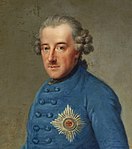
Frederick the Great (1712–1786) was King of Prussia from 1740 until his death. His most significant accomplishments included his military successes in the Silesian wars, the First Partition of Poland, and his patronage of the arts and culture. Prussia became a major power in Europe under his rule. Frederick was a proponent of enlightened absolutism, stating that the ruler should be the first servant of the state. He modernised the Prussian bureaucracy, reformed the judicial system, encouraged immigrants of various nationalities and faiths to come to Prussia, and increased freedom of the press in Berlin. Frederick was also an accomplished musician, writer, and philosopher. He played the flute, and wrote over 100 scores, including flute sonatas and opera libretti. His collected works of poetry, histories, and philosophy spans 30 volumes and his political correspondence spans 46 volumes. He remains an important symbol of modern Germany to this day. (Full article...)
November 10
Operation Grapple was a series of British nuclear weapons tests carried out in 1957 and 1958 at Malden Island and Christmas Island in what is now Kiribati. Britain had successfully tested an atomic bomb in October 1952, and in July 1954, decided to develop a hydrogen bomb. In the first test, Grapple 1 (pictured), the bomb's yield was below its designed capability. The second, Grapple 2, was the largest ever achieved by a single-stage device. The third, Grapple 3, also had a low yield. A further test, Grapple X, exceeded expectations. Grapple Y, in April 1958, yielded about three megatonnes and remains the most powerful British nuclear weapon ever tested. Much of its yield came from its thermonuclear reaction, making it a true hydrogen bomb, and the United Kingdom became the third nation to possess one. A final series of four tests, Grapple Z, tested techniques for making bombs immune to predetonation by nearby nuclear explosions. (This article is part of a featured topic: Nuclear weapons and the United Kingdom.)
November 11

Cimoliopterus is a genus of pterosaur that lived during the Late Cretaceous. The first known specimen, consisting of the front part of a snout, was discovered in Kent, England, and described as the new species Pterodactylus cuvieri in 1851. It was depicted as models in Crystal Palace Park in the 1850s. In 2013, the species was moved to a new genus, as Cimoliopterus cuvieri. In 2015, a snout discovered in Texas was named as C. dunni, a new species in the genus. C. cuvieri is estimated to have had a wingspan of 3.5 metres (11 ft), and C. dunni is thought to have been similar in size. Cimoliopterus would have been covered in pycnofibres (hair-like filaments), and had extensive wing-membranes, distended by long wing-fingers. They were probably adapted for long-distance oceanic soaring; their fossils have mainly been found in marine settings. They possibly fed while flying by dipping their long jaws into water and catching fish with their interlocking teeth. (Full article...)
November 12
Interstate 82 (I-82) is an Interstate Highway in the Pacific Northwest region of the United States that passes through parts of Washington and Oregon. It runs southeasterly for 144 miles (232 km) from I-90 in Ellensburg, Washington, to I-84 in Hermiston, Oregon. The highway passes through Yakima, the Yakima Valley agricultural region, and the Tri-Cities area, also serving as part of the link between Seattle and Boise, Idaho. It crosses the Columbia River on the Umatilla Bridge (pictured), which opened in 1955 and was later twinned. The corridor was originally used by several state and national highways until I-82 was created in late 1957. The first section to be constructed was a bypass of Yakima, opened in 1963, which was extended north to Ellensburg on November 12, 1971. The Yakima Valley section, connecting Union Gap to Prosser, was constructed between 1977 and 1982. The Tri-Cities bypass opened in 1986, delayed by a lengthy routing dispute, and the final section was completed in 1988. (Full article...)
November 13
The Transcaucasian Democratic Federative Republic (TDFR) was a short-lived state in the Caucasus that included most of the territory of present-day Armenia, Azerbaijan and Georgia, and parts of Russia and Turkey. The region was part of the Russian Empire, but as this dissolved in 1917 with the February and October Revolutions the Transcaucasian Commissariat took over in Transcaucasia. In March 1918, as the First World War continued, the Commissariat initiated unsuccessful peace talks with the Ottoman Empire, which had invaded the region. Russia withdrew from the war later that month, conceding parts of the Transcaucasus to the Ottomans. Faced with an Ottoman offensive, on 22 April 1918 the Commissariat dissolved itself and established the TDFR. Akaki Chkhenkeli (pictured) served as both prime minister and foreign affairs minister. The Ottoman Empire immediately recognized the TDFR, which directed its legislature, the Seim, to hold peace talks. These broke down and, fearing fresh Ottoman attacks, Georgian delegates in the Seim declared independence on 26 May. Armenia and Azerbaijan each declared themselves independent on 28 May, ending the federation. (Full article...)
November 14
Tornado over Kansas is a 1929 oil-on-canvas painting by the American Regionalist painter John Steuart Curry. It depicts a dramatic scene in which a family races for shelter as a tornado approaches their farm, and has compositional connections to Curry's earlier 1928 painting Baptism in Kansas. The artist was influenced by Baroque art and photographs of tornadoes. He developed a fear of natural disasters and a reverence towards God during his childhood, both of which seem apparent in the painting. Following its 1930 debut, the painting was considered a notable Regionalist work, but native Kansans disliked the choice of subject matter. Although the painting won awards and was lauded by some, others criticized Curry's amateur style of painting. It is among several of Curry's works depicting tornadoes, including a set of 1932 lithographs. Tornado over Kansas has been widely reproduced in publications including Time and Life magazines, and is now among Curry's best-known works. (Full article...)
November 15
Leighton Durham Reynolds (1930–1999) was a British Latinist who is best known for his work on textual criticism. He spent his teaching career at Brasenose College, Oxford (pictured), where he published the most commonly cited edition of Seneca the Younger's Letters. The central academic achievement of his career was his monograph The Medieval Tradition of Seneca's Letters (1965), in which he reconstructed how the text was transmitted through the Middle Ages. He also wrote critical editions of Seneca's Dialogues, the works of the historian Sallust, and Cicero's De finibus bonorum et malorum. In 1968, Reynolds and his Oxford colleague Nigel Wilson co-authored a well-received introduction to textual criticism. Writing about the set of critical editions authored by Reynolds, the Latinist Michael Reeve stated that Reynolds's scholarship "cut through dozens of manuscripts to the serviceable core". When published, his work on Seneca was considered by some commentators to be difficult to surpass. (Full article...)
November 16
The UEFA Euro 2008 Final was the last match of Euro 2008, UEFA's competition for national football teams. The match was played at Ernst-Happel-Stadion (pictured), Vienna, Austria, on 29 June 2008, and was contested by Germany and Spain. The sixteen-team tournament had a group stage, from which eight teams qualified for the knockout phase. Germany lost to Croatia and beat Poland and Austria in Group B, and defeated Portugal and Turkey in the knockouts. Spain beat Russia, Sweden and Greece in Group D, and defeated Italy and Russia again in the elimination games. The final took place in front of 51,428 supporters and was refereed by Roberto Rosetti from Italy. Spain took the lead in the 33rd minute through Fernando Torres. There were no more goals and Spain won 1–0 to secure their second European title. Torres was named the man of the match. Spain went on to win the 2010 FIFA World Cup in South Africa, and retained their European title at Euro 2012. (Full article...)
November 17
HMS Hood was a battlecruiser of the British Royal Navy, commissioned in 1920. Hood was the largest warship in the world for 20 years and was nicknamed "the Mighty Hood". She was involved in several showing-the-flag exercises prior to the outbreak of World War II in 1939. She was scheduled to undergo a major rebuild in 1941 but the war prevented this. In July 1940 she participated in the destruction of the French fleet at Mers-el-Kébir. On 24 May 1941 Hood and the battleship Prince of Wales intercepted the German battleship Bismarck and the heavy cruiser Prinz Eugen in the Battle of the Denmark Strait. Hood was struck by several German shells, exploded, and sank with the loss of all but three of her crew of 1,418. The Royal Navy conducted two inquiries; both concluded that Hood's aft magazine exploded after a shell penetrated her armour. Hood's wreck was discovered in 2001. (This article is part of a featured topic: Battlecruisers of the world.)
November 18
Walt Whitman and Abraham Lincoln never met, but the American poet greatly admired Lincoln, the 16th president of the United States, and was deeply affected by his assassination, writing several poems as elegies and giving a series of lectures on Lincoln. Shortly after the assassination, Whitman hastily wrote the first of his Lincoln poems, "Hush'd Be the Camps To-Day". Two more appeared in his collection Sequel to Drum-Taps later in 1865: "O Captain! My Captain!" and "When Lilacs Last in the Dooryard Bloom'd". The poems—particularly "My Captain!"—were popular upon publication and, in the following years, Whitman styled himself as an interpreter of Lincoln. In 1871, his fourth poem on Lincoln, "This Dust Was Once the Man", was published. "My Captain!" is still one of Whitman's most popular works, despite slipping in popularity and critical assessment since the early 1900s. "Lilacs" is often listed as one of Whitman's finest works. (This article is part of a featured topic: Walt Whitman and Abraham Lincoln.)
November 19

The Wii is a home video game console developed and marketed by Nintendo. The fifth major home console released by the company, it is the successor to the GameCube and was released on November 19, 2006. Although a competitor in the seventh generation of video game consoles, the Wii aimed to appeal to a larger and broader target demographic, directing towards the "casual" market rather than the "core" audience. Features of the console include a controller that can be pointed at the screen to function as a pointing device, a Wi-Fi connection via WiiConnect24, and easy-to-navigate software. The console was formally revealed at E3 in 2005 by Satoru Iwata under the code name "Revolution". Other variants, such as the Wii Mini, were also released. The console won numerous awards and was praised for its broad-audience simplicity with some criticism for hardware limitations. By 2013, the Wii had sold over 100 million consoles internationally and was followed by the Wii U in 2012. (Full article...)
November 20
The Harry F. Sinclair House stands at the corner of East 79th Street and Fifth Avenue in Manhattan, New York City. It was built between 1897 and 1899, designed in a French Renaissance style by C. P. H. Gilbert and built by foreman Harvey Murdock. It was successively owned by businessmen Isaac D. Fletcher and Harry F. Sinclair, and then descendants of Peter Stuyvesant. The Ukrainian Institute of America acquired the mansion in 1955. It fell into disrepair and was renovated in the 1990s. The house was added to the National Register of Historic Places and named a National Historic Landmark in 1978. The building largely retains its original design, being constructed mainly of brick faced with limestone ashlar. The northern façade on 79th Street includes the main entrance and has multiple windows in square recesses or Gothic arches. The western façade is symmetrical and dominated by a curved pavilion. The interior has six floors, with a total floorspace of 20,000 square feet (1,900 m2). (Full article...)
November 21
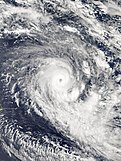
Intense Tropical Cyclone Berguitta was a strong tropical cyclone which originated southwest of the Chagos Archipelago on 10 January 2018. It achieved its peak intensity on 15 January and degraded to a tropical storm by 17 January. It accelerated southwestwards over Mauritius and Réunion on 18 January and degenerated to a post-tropical cyclone the next day. Parts of Mauritius experienced a quarter of its average annual rainfall in three days, resulting in widespread floods. Economic losses in Mauritius were estimated at ₨ 2 billion (US$59 million). The southern part of Réunion was hard-hit by floods and landslides and several rainfall records were broken. Grand Coude experienced 1,862 mm (73.3 in) of rain in eight days, including 848 mm (33.4 in) in 24 hours. Flooding caused widespread damage to roads and agriculture. Nearly 100,000 customers were left without electricity, while water supplies were widely interrupted. Economic losses in Réunion were estimated at €41 million (US$48 million). (Full article...)
November 22
The Great Gatsby is a 1925 novel by American writer F. Scott Fitzgerald. Set in the Jazz Age on Long Island, near New York City, the novel depicts first-person narrator Nick Carraway's interactions with mysterious millionaire Jay Gatsby and Gatsby's obsession with his former lover, Daisy Buchanan. The book was inspired by a youthful romance Fitzgerald had with socialite Ginevra King, and the riotous parties he attended on Long Island's North Shore in 1922. The Great Gatsby received favorable reviews but was a commercial disappointment, selling fewer than 20,000 copies in the first six months. At the time of the author's death in 1940, he believed himself to be a failure and his work forgotten. During World War II, the novel surged in popularity when the Council on Books in Wartime distributed free copies to American soldiers serving overseas. This newfound popularity launched a critical re-examination, and now the book is widely considered to be a literary masterwork. (Full article...)
November 23
The Short Symphony, or Symphony No. 2, is a symphony written by the American composer Aaron Copland from 1931 to 1933. The name derives from its short length of only 15 minutes. The work is dedicated to Copland's friend, the Mexican composer and conductor Carlos Chávez (pictured). The composition contains complex rhythms and polyharmonies, and incorporates the composer's emerging interest in serialism and Mexican music. Copland later arranged the work as a sextet. The symphony was not widely performed during Copland's lifetime, largely due to the piece's rhythmic difficulties. After Serge Koussevitzky and Leopold Stokowski both declined to conduct the premiere, Chávez agreed to deliver it in 1934 in Mexico City. Though Copland thought of the Short Symphony as "one of the best things I ever wrote", some critics found it to be fragmented and cacophonous. Others agreed with Copland's assessment, describing the symphony as a masterpiece and a significant work in both Copland's career and modernist music. (Full article...)
November 24
Uturuncu is a dormant volcano in the Sur Lípez Province of Bolivia that has active fumaroles between its two summits. Its name means "jaguar" in Quechua. The highest mountain in southwestern Bolivia, it rises to 6,008 metres (19,711 ft) within the Altiplano–Puna volcanic complex, a province of large volcanoes and calderas which over the last few million years have emplaced about 10,000 km3 (2,000 cu mi) of ignimbrites in large eruptions. Uturuncu's last eruption was about 250,000 years ago. Although it has no glaciers at present, it shows traces of a former glaciation. Underneath it lies the Altiplano–Puna Magma Body, a large sill formed by partially molten rocks. Since 1992, satellite observations have indicated a large area of regional uplift centered on Uturuncu, which may indicate magma intrusion under the volcano. This might be a prelude to large-scale volcanic activity, including supervolcanic activity and caldera formation. (Full article...)
November 25
B. Max Mehl (1884–1957) was a prominent coin dealer in the U.S. for more than 50 years. He was born in Congress Poland, which was then part of Imperial Russia, but his family moved to present-day Lithuania, and then to the U.S.; Mehl lived in Fort Worth for most of his life. He started selling coins as a teenager, and joined the American Numismatic Association aged 18. By 1910 he was one of the most prominent dealers in the U.S. His customers included Franklin D. Roosevelt and Winston Churchill. He auctioned coins from the collections of prominent numismatists, and he was the first dealer to advertise in non-specialist publications, helping to broaden the hobby's appeal. To generate interest and sell his books, he offered to buy a 1913 Liberty Head nickel for $50, knowing there were none in circulation. His great auction sales were in the 1940s, but he later became less active and he died in 1957. He was elected to the Numismatic Hall of Fame in 1974, and the CoinFacts Dealer Hall of Fame in 2010. (Full article...)
November 26
"Fuck the Millennium", sometimes "***k the Millennium", is a protest song by 2K—Bill Drummond and Jimmy Cauty. The duo are better known as the Justified Ancients of Mu Mu (the JAMs) or the KLF. The song was built around the KLF and Acid Brass's versions of "What Time Is Love?", and premiered at 2K's "1997" event, held at London's Barbican Centre on 17 September 1997 and directed by Ken Campbell. 2K's lifespan was billed as the duration of the live event's performance—23 minutes. The song was released as a comeback single to mark the tenth anniversary of Drummond and Cauty's first collaborations; however, the performance and single were also in part intended to mock the notion of the comeback. The song reached number 28 in the UK Singles Chart in October 1997. Drummond and Cauty's promotional campaign also involved plans to construct a 150-foot-high (46 m) pyramid from bricks; it was never built. (Full article...)
November 27
A carillon is a pitched percussion instrument housed in a bell tower and played with a keyboard. Consisting of at least 23 cast bronze bells in fixed suspension and tuned in chromatic order, carillons are usually owned by churches, universities, or municipalities. The bells are struck with clappers connected to a keyboard of wooden batons played with the hands and pedals played with the feet. They are among the world's heaviest instruments, usually between 4.5 and 15 metric tons (5.0 and 16.5 short tons). The tuned carillon was invented in the Netherlands in 1644, cast by Jacob van Eyck and the Hemony brothers. Today, most are found in and around Belgium, the Netherlands, and northern France, though nearly 200 are in North America. Almost all existing carillons were built in the 20th century. In 2014, UNESCO recognized the carillon cultures of the Netherlands and Belgium as part of their intangible cultural heritage. (Full article...)
November 28
The British depended on complex logistical arrangements to recapture the Falkland Islands in 1982, as the British forces were operating 13,000 kilometres (8,000 mi) from home. The Royal Navy's ships were augmented by ships taken up from trade (STUFT), and a base was developed on remote Ascension Island. The 3rd Commando Brigade was landed in May on East Falkland, but struggled to build up its supplies as the Argentine air forces made repeated attacks on ships. SS Atlantic Conveyor was struck by a missile, and sank with Chinook and Wessex helicopters (example pictured) on board, along with vital stores. This forced the 3rd Commando Brigade to yomp across East Falkland. Forward Brigade Maintenance Areas were established, and ammunition was delivered to gun positions by helicopters to enable the artillery to support the attacks on the mountains ringing Port Stanley. The successful conclusion of these battles resulted in the surrender of the Argentine forces in June. (Full article...)
November 29
The jaguar (Panthera onca) is a large cat and the only Panthera species native to the Americas. With a body length of 1.12 to 1.85 m (3 ft 8 in to 6 ft 1 in) and a weight of 56 to 96 kg (123 to 212 lb), it is the third-largest cat species in the world. Its coat is covered by spots that transition to rosettes on the sides. The jaguar's range extends from the southern U.S. through Mexico and across much of Central America to Paraguay and northern Argentina. It inhabits forested and open terrain, but prefers dense jungle. It is adept at swimming and is largely a solitary, opportunistic, stalk-and-ambush apex predator. The wild jaguar population is thought to have declined since the late 1990s, and is threatened by habitat loss and fragmentation, poaching and human–wildlife conflict. Since 2002, it has been listed as a near-threatened species on the IUCN Red List. The jaguar has featured prominently in indigenous cultures of the Americas, including the Maya and Aztec civilizations. (Full article...)
November 30
John McGraw (1873–1934) was a Major League Baseball (MLB) player and manager who managed the New York Giants for almost thirty years (1902–1932). He was also the third baseman of the 1890s Baltimore Orioles. The Orioles, who won three National League (NL) pennants, were noted for their innovative, aggressive play, perfecting the hit and run and popularizing the Baltimore chop. They also sought to win by intimidating the opposing team and the umpire. After one season with the St. Louis Cardinals (1900), McGraw returned to Baltimore as player and manager of the new Orioles of the American League (AL). He jumped to the Giants in 1902, taking several Orioles players with him. Through his many years managing the Giants, McGraw exerted control on players and team, and saw great success, winning ten pennants (tied for most by a manager) and three World Series; his total of 2,763 victories ranks third among MLB managers. McGraw has been called one of the greatest managers in baseball history. (Full article...)



